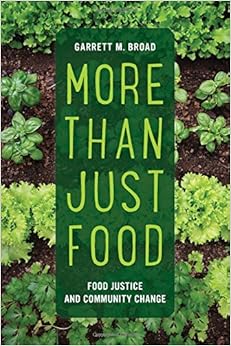Join Health Affairs for a virtual conversation between me and Angela Odoms-Young of Cornell University discussing the evolution of US food and nutrition policy, the current policy landscape, and thoughts on what lies ahead. It’s at 1:00 p.m. EDT. To join the Webinar, click here.
Weekend reading: Garrett Broad’s More Than Just Food
Garrett M. Broad. More Than Just Food: Food Justice and Community Change. University of California Press, 2016.

I particularly wanted to read this book for two reasons, one personal and one professional.
First the personal. The book’s University of California Press publication was supported by the Anne G. Lipow Endowment Fund for Social Justice and Human Rights, established by Stephen M. Silberstein. Anne and I were friends from the time our children were babies. Sadly, she died in 2004. Steve, her husband, set up this endowment in her honor.
On the professional side, More Than Just Food is based on Garrett Broad’s dissertation research. As he explains,
More Than Just Food offers an ethnographic exploration of community-based food justice activism in urban America, using the network of Community Services Unlimited, Inc. (CSU) as a centering artifact of study. CSU was initially created as the nonprofit arm of the Southern California chapter of the Black Panther Party and today stands as a leading food justice nonprofit organization in its own community of South Los Angeles, with connections to other food justice groups from across the United States and around the world.
To study this group and food justice organizations in general, Broad joined the CSU and participated in its activities in a process he calls “engaged scholarship.” He has especially interesting things to say about the differences he observed between community-based groups like CSU and outside groups coming into communities that are part of the “nonprofit industrial complex.”
His research was based on theory, the communication ecology perspective, and is academically rigorous.
I argue that food justice activism can be understood as a hybrid praxis, an ever-evolving mix of philosophy and action that takes shape through an ongoing process of co-construction, collaboration, and conflict in food justice work.
With that out of the way, his research led to especially useful insights into food as a tool for community organizing.
The analysis in this book has emphasized how, even as community-based activists make food a centerpiece of their organizing work, they also insist than an isolated focus on food and food alone will not lead them to their ultimate goals. Instead, guided by a broader social justice vision, food justice organizations offer up food as a uniquely engaging tool that helps build critical consciousness, develop alternative institutions, promote economic development, and cultivate skills for health and well-being among those who have long been subject to injustice in the food system and beyond.
This book is an entirely fitting tribute to Anne Lipow’s memory and I look forward to seeing more in this series.

